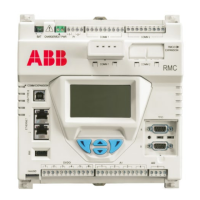2105551MNAD | RMC-100 | 33
Figure 8-5: Pulse input configuration
3. Go to the Debounce area of the screen.
4. Select On if debounce is required. Set this for each PI port if debounce is needed.
5. Click Send.
8.6 Expand I/O capacity with the ABB XIO
The RMC supports I/O expansion through ABB’s Extensible IO devices (XIO). The RMC can poll and write
from/to peripherals connected to TFIO Modules installed on the XIO. The RMC’s XIO Interface application
is designed to handle communication transparently with the TFIO modules as if the modules were directly
connected to the RMC.
XIOs and directly attached TFIO modules can be co-located with an RMC on the same cabinet or be in
their own enclosure at a distance from the RMC in the same field. RMC-XIO communication is over
Ethernet. For additional details, refer to the XIO user manual and the I/O Interface Application guide.
See Additional information
for links to the documents.
9 Configure directly attached TFIO interfaces
To scan and transmit data using the TFIO modules, the RMC TFIO interfaces must be enabled. Connected
TFIO modules are detected only when the interfaces are enabled. This procedure describes how to enable
the TFIO interface on the RMC.
Refer to the IO Interface application guide for additional details to configure and troubleshoot
communication with TFIO modules. See the Additional information
section for a link to the guide.
The TFIO-A interface is enabled by default. The TFIO-B is disabled by
.
PCCU32 version 7.68 and later support TFIO module hot swap and
additional configuration and troubleshooting options
not available on earlier versions of
To verify or enable communication with TFIO modules:

